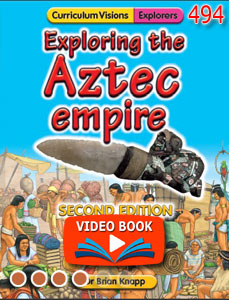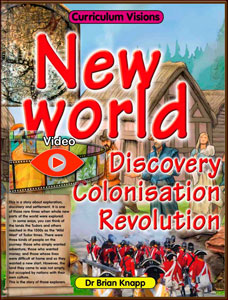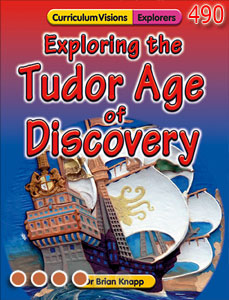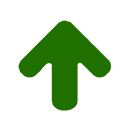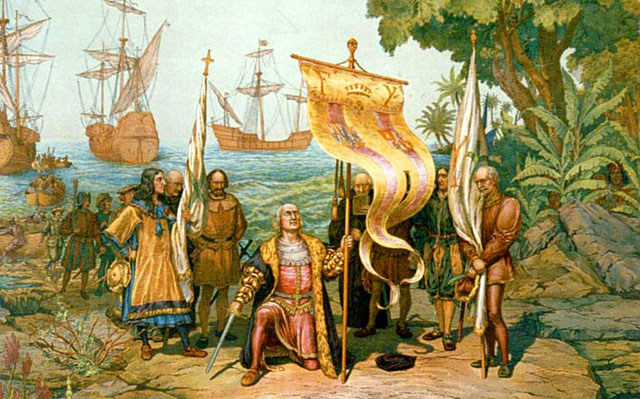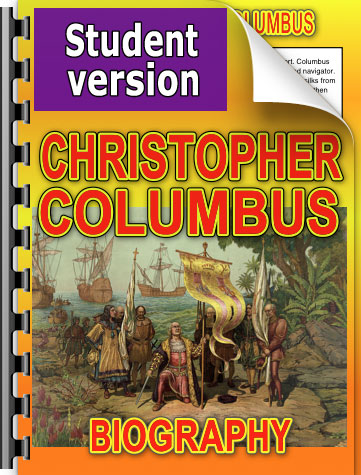Christopher Columbus was an Italian ship's captain for hire. He wanted to try to find a way to China, and the spices and other valuable goods that could be found there, and he thought that could be done most quickly by sailing westwards. However, no one had ever done that before because it meant sailing little ships across a large ocean. Although the ships were better than they had been in the past, with high sides to stop them being swamped by waves, no one had ever tested how good they were. So his proposal was a very risky one.
He had a to try a number of countries before he could find one that would pay for his expedition, but on August 3, 1492, he was able to sail from the Spanish port of Palos in three ships - the Nina, the Pinta and the Santa Maria.
Columbus went first to the Canary Islands off the African coast. On Sept 6 he began his voyage, finding there were calm seas and steady winds that pushed him steadily westward. These winds were the Trade Winds; Columbus was the first to discover them, but they would be used by sailors in sailing ships ever after to reach the New World.
Columbus had no idea how long his voyage would take, and he nearly ran out of food and water. The crew became unsettled. To make the crew less worried he kept two sets of records: one showing the true distance travelled each day (which he kept locked away), and one showing a smaller distance, which he showed to the crew.
All the same, by October 10 the crew was close to mutiny. Fortunately, the next day land was sighted. This was later to be called the Bahamas.
“Thursday October 11
The course was W.S.W., and there was more sea than there had been during the whole of the voyage. They saw sand-pipers, and a green reed near the ship. Those of the caravel Pinta saw a cane and a pole, and they took up another small pole which appeared to have been worked with iron; also another bit of cane, a land-plant, and a small board. The crew of the caravel Niña also saw signs of land, and a small branch covered with berries. Everyone breathed afresh and rejoiced at these signs. The run until sunset was 27 leagues.
After sunset [Columbus] returned to his original west course, and they went along at the rate of 12 miles an hour. Up to two hours after midnight they had gone 90 miles, equal to 22 1/2 leagues. As the caravel Pinta was a better sailor, and went ahead of [Columbus], she found the land, and made the signals ordered by [Columbus], …shining a wax candle.
Columbus ordered the three ships to halt and wait for daylight before going further. Remember he thought he was going to Asia, and in particular to India, so he believed the people were from India, that is Indians.
“Friday October 12
On Friday they arrived at a small island called, in the language of the Indians, Guanahani. Presently they saw naked people. [Columbus] went onshore in the armed boat, and Martin Alonso Pinzon, and Vicente Yanez, his brother, who was captain of the Niña. [Columbus] took the royal standard, and the captains went with two banners of the green cross, which [Columbus] took in all the ships as a sign, with an F and a Y and a crown over each letter, one on one side of the cross and the other on the other.
Having landed, they saw trees very green, and much water, and fruits of diverse kinds. [Columbus] called to the two captains, and to the others who leaped on shore, and to Rodrigo Escovedo, secretary of the whole fleet, and to Rodrigo Sanchez of Segovia, and said that they should bear faithful testimony that he, in presence of all, had taken, as he now took, possession of the said island for the King and for the Queen his Lords, making the declarations that are required, as is now largely set forth in the testimonies which were then made in writing.”
Shortly after landing, many of the island’s inhabitants assembled on the beach and Columbus gave them gifts of red hats and beads. The natives reciprocated with gifts of parrots, cotton and other goods.
